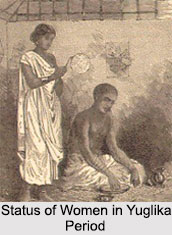 In the Yuglika period, boy and girl i.e. twins, who were born together, lived together like brother and sister till maturity, later became life partners. For them, inequality of man and woman did not arise. Jain history says that Rishabhadeva was the last person of the Yuglika period and also the first person to break this tradition when he married Sunanda to give her security whose twin brother had died in an accident. Sumangala, his first wife had no objection for his remarriage.
In the Yuglika period, boy and girl i.e. twins, who were born together, lived together like brother and sister till maturity, later became life partners. For them, inequality of man and woman did not arise. Jain history says that Rishabhadeva was the last person of the Yuglika period and also the first person to break this tradition when he married Sunanda to give her security whose twin brother had died in an accident. Sumangala, his first wife had no objection for his remarriage.
Some of the earlier women are cited as follows:
Marudevi (mother of Rishabhadeva): She was the first lady to attain Kevaljnana in present Avasarpini part of Kala Chakra.
Brahmi and Sundari (daughters of Rishabhadeva): They were the first ladies to learn Maths, calligraphy and languages. Sundari led a life of spinsterhood and became nun, and Brahmi was appointed as the head of the nun`s group which included 3 lac nuns and 54 thousand Sravikas.
Tirthankara Mallinath: The 19th Tirthankara, Mallinath is the only female Tirthankara. This legend offers an opportunity to look into the factors that lead to rebirth as a woman. The soul that became female, Malli was a king Mahabala in the previous birth. He renounced the world together with seven friends, and they became Jain mendicants. It is customary for a Jain monk to observe fasts and other special austerities. But, Mahabala by nature was deceitful and gave excuses of ill health for not observing fasts etc. His conduct was otherwise harmless, and as a consequence of his great exertions in leading a holy life, he generated karmic forces as would yield him rebirth as would be Jina; one whose conception (garbha), birth (janma), renunciation (diksha), enlightenment (Kevaljnana) and death (nirvana) would be celebrated as auspicious events by Gods and men. Therefore, the cunning monk Mahabala was reborn as a princess Malli, a female and the other seven monks were reborn as members of warrior caste and ruled the neighbouring kingdoms. They all sought Malli"s hand in marriage and went to war over her. Malli was disgusted to be regarded as a sexual object and one that led to violence; she renounced the world in that very young age and attained Kevaljnana/omniscience the very same day of her renunciation and became Jina, thus attaining a status equal to that of Lord Mahavira.
Rajimati: A would be wife of Lord Neminath who renounced without marrying her became an inspiration for Rajimati to become a nun. She also comprehended Rathnemi - a monk and brother-in-law who proposed her for marriage. She intelligently explained and convinced him about the holiness of monkhood. Certainly she was a symbol of chastity, faithfulness and followed rules of monasticism very strictly.
Pushpachula: She was appointed as head of the nunnery (16000 nuns) by Lord Parashvanath.
It is said that after the period of Lord Parashvanath, there was a decline in the strict discipline in the monks and the nuns as they were having luxurious lives then. Lord Mahavira introduced the 5th vow of celibacy. This gave women an opportunity to elevate themselves.




















